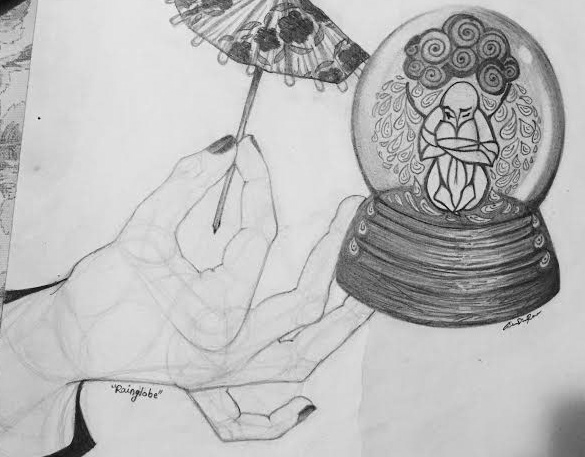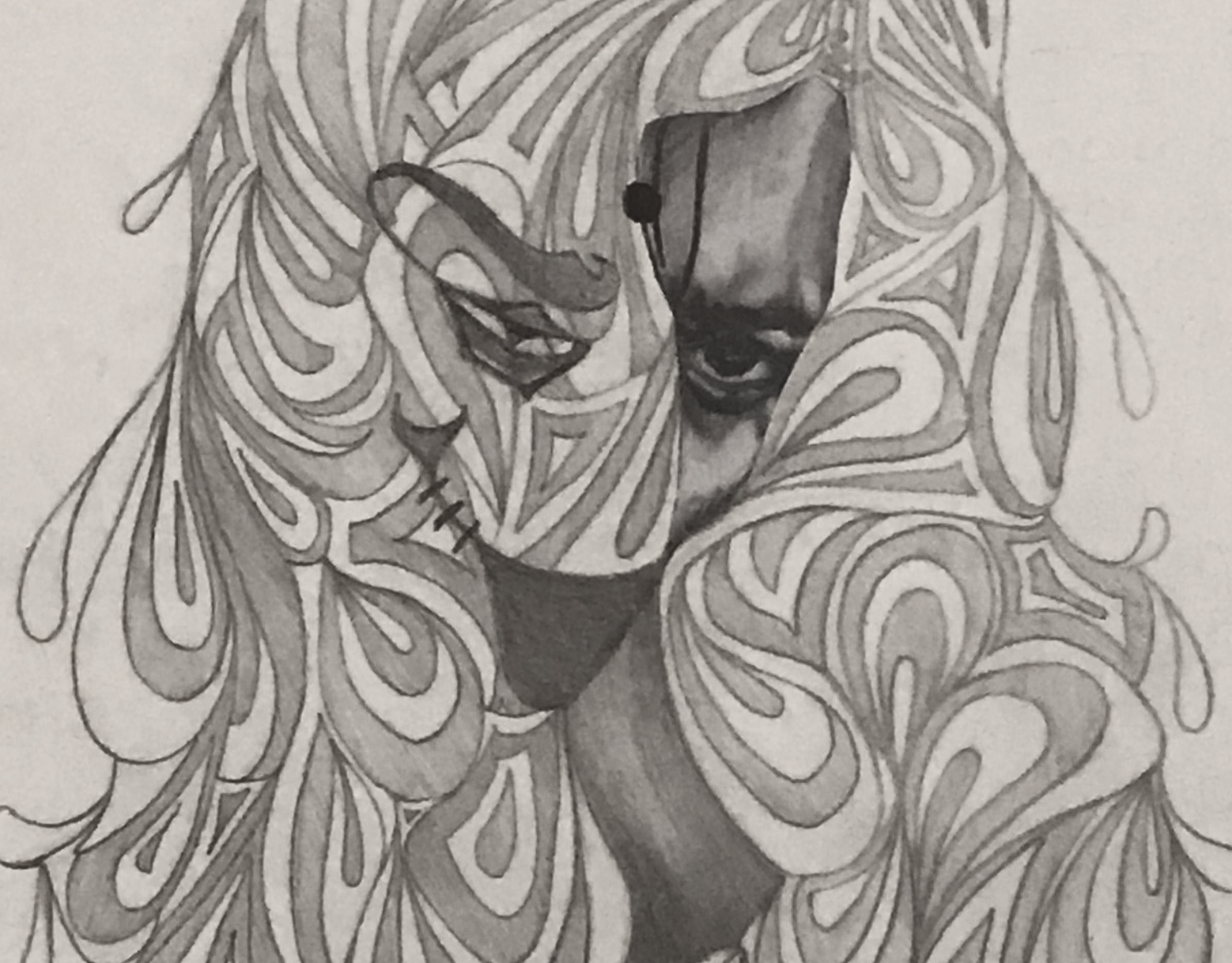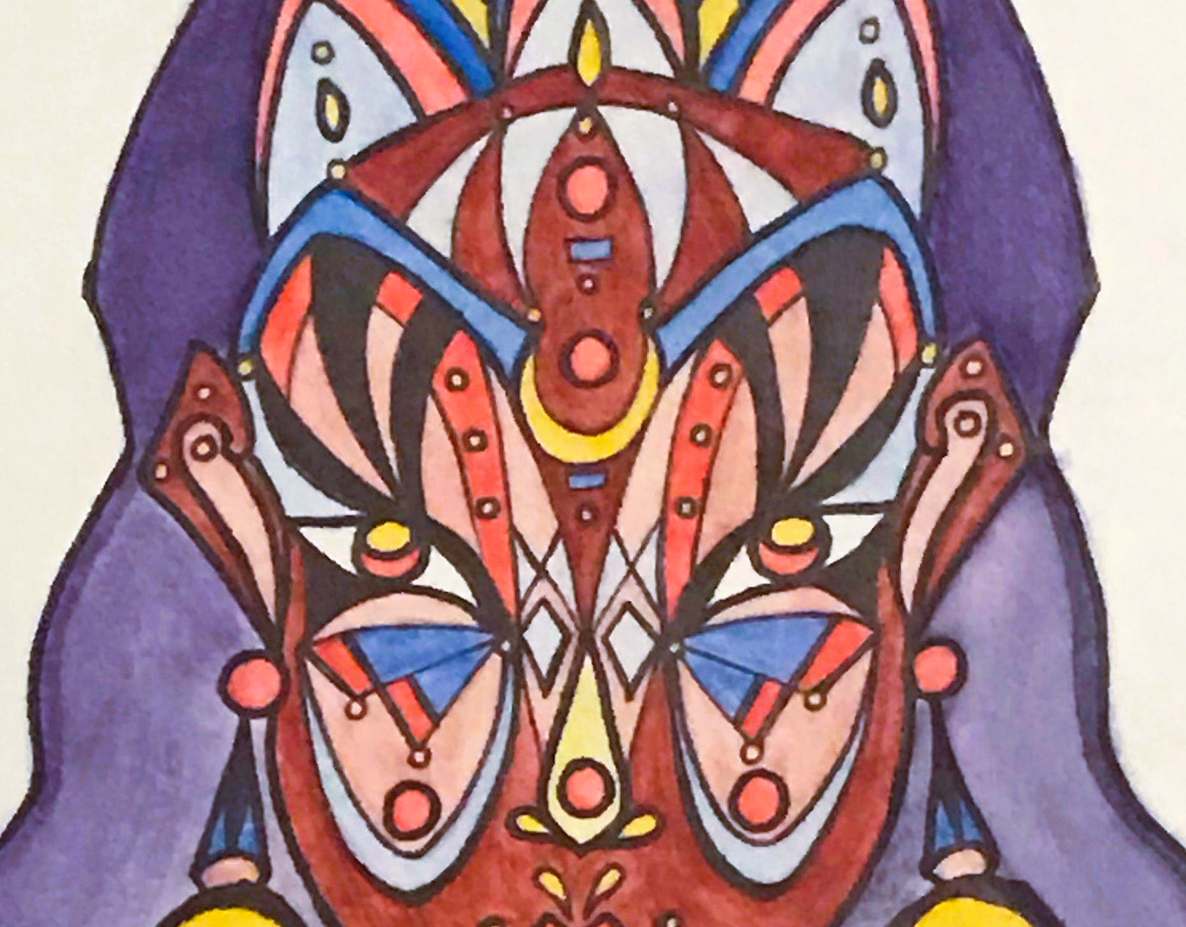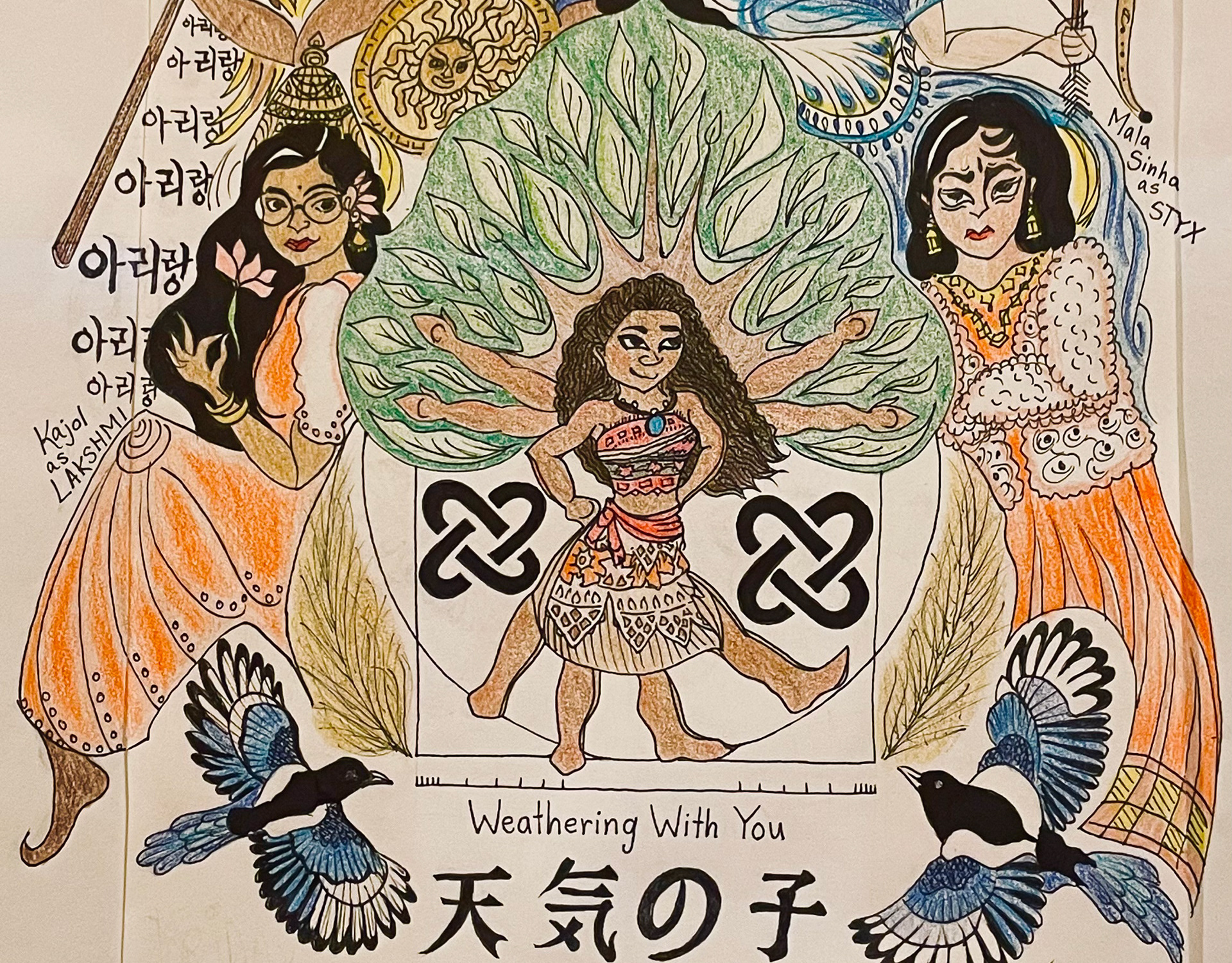“Beomgyu” (2019)
Freehand sketch with pencil. This illustration is of Beomgyu, a Korean pop idol from the band, "TXT (Tomorrow by Together)". The aim of this piece was to practice drawing a three-fourths profile of a male subject. Focus was kept on bringing out the eyelashes, subtle lips, and hair. This was drawn in a realistic style, to test the artist's ability to capture a subject quickly.
More from this Category:

"Tamilian Grandmother" (2014)
Freehand ink sketch of a South Indian Tamilian grandmother with two nose stud piercings. The style of her bottu/bindi is also associated with Tamil culture. For the sake of the sketch and in a break from the typical bottu/bindi, this design is repeated along the bridge of the nose. The eyes are slender and wing-shaped; the tinge of blue in them represents the onset of old age in a dark eyes. The hair is shown to be white and black, and bursting flowers are tucked behind both of the grandmother's ears. Her necklace is shown in the upper-right of the sketch. A hint of colored pencil was used to color the blue-green in her eyes and in her face. The lips are curved to indicate a hidden smile. This style is influenced by Bapu, a South Indian Telugu artist.

"Rainglobe: Trapped Angel" (2016)
Illustrated with pencil for a Drawing class assignment, in which students were instructed to create a piece that incorporated a hand, an object, and glass. Thus, this illustration is of a small, isolated, angelic figure trapped in a globe. A raincloud in the globe showers onto them, and the feathery drops turn into wings. Hence, the title of the piece. Meanwhile, outsiders attempt to offer comfort, represented by a hand holding a cocktail umbrella up to the glass. However, their efforts are futile; the figure is beyond their reach, and it will take more than a frail umbrella to shatter the glass. The figure, drafted in the second image below (you'll see it when you scroll down), has wrapped their limbs into a near-fetal position. They peek out at the hand, at the comfort being offered, but do not engage with it. Note the use of shading in the glass and wooden base of the globe, the high contrast of the figure's outline, a spot of light upon the glass, and the mechanical drawing style of the hand which breaks it into its simplest forms.

"Umbrella Buddies" (2020)
Drawn with colored pencils and ink. This illustration is of a green songbird and a squirrel clutching an umbrella for them to share under pouring raindrops and snowflakes. All elements of this piece are drawn stylistically, with curved shapes, looped lines, and zig-zagged puddles. A warm color scheme was used for the squirrel and cool tones were used for the songbird. Both are wrapped in similar yellow scarves, and both have tilted, black eyes. The shapes of their bodies are brought out through repetition in linework, and repetition is also seen in the patterns of rain and snow. The umbrella handle tapers down to a few dots, as though it is made of a twig. The mood of the piece is meant to be cheerful, festive, and merry. An ink outline is provided below (scroll down).

"Outer Animal, Inner Anguish" (2016)
Pencil drawing created for Drawing course. Displayed at Anglo-American School of Moscow. Realistic sliver of a face shows a tortured inner self, fighting for control inside the mind of a monstrous external self, shown with the cartoonish outer eye and stitched smile. A bindi/bottu holds both the external and internal self together, at the seams. The hair is drawn stylistically, with fluid shapes and slight curves fitted next to triangles.

"Crescent-Swing, Smoke-Clouds" (2016)
Drawn with ink. This sketch shows a slender hand holding a cigarette, and the illusions inside the smoke cloud. There are two eyes, fanning out like wings, and multiple crescent shapes are present. One crescent holds a ladder which pours down towards a figure, reaching out to climb it. Another crescent holds a swing, while yet another serves as a bed. A crescent ship with a figure on top sits next to an ocean. A crescent swings beneath the ship in the form of an anchor. The last hidden crescents are in the bindi/bottu of the face and in the eyes themselves to mark a line of symmetry. Finally, a face peers from behind at the cloud and the smoker. The style was meant to be surreal, dreamy, yet frazzled. The figures are inspired by Warli folk art from the Indian state of Maharashtra.

"Crescent Woman" (2014)
Watercolor pencil and ink painting of a woman, inspired by traditional African masks and South Indian Tamil style bottus (spiritual third eyes and marks of which Hindu deity one worships). This features the artist's love for finding and bringing out symmetry with geometric shapes in human faces, namely focusing on crescent, circular, and triangular shapes. Style is also influenced by Bapu, a South Indian Telugu artist who worked with bold colors and continuous lines.

“Flute Choir: Spring Concert" (2023)
Drawn with ink and colored pencil. Goal of the design was to showcase multi-cultural unity between symbolic figures from historic art, music, mythology, and film- this aligned with the showcase theme of bringing diverse music to the flute choir group. (From center to outward layers) Moana, a Polynesian princess from Disney's film "Moana" stands center, since "How Far I'll Go" was being performed. She poses with with two extra sets of limbs, at the center of a square and circle, with a line and short marks, all drawn in a nod to the famous "Vitruvian Man" drawing by Italian artist Leonardo da Vinci, to represent human anatomy. Her arms make up the branches and her legs make up the roots of a tree, representing nature. So, this combination was meant to show Human + Nature = Human Nature, since "Human Nature" by Michael Jackson was being performed. On her right and left, there is a symbol of "Unity" or "Umoja" from the seven principles of the African holiday of Kwanza, since "Umoja," composed by Valerie Coleman, was being performed. Excerpts from the OST of a Japanese animated film, "Weathering With You" were being performed, so the title was written in English and Japanese at the bottom, while a character (wearing a red bow and yellow boots) was drawn at the top of the page. Three Korean folk songs were represented: "Blue Bird" was shown in two Korean blue birds, which carry special symbolism; "Gold Grass" was shown in two bunches of the plant on either side of Moana's tree; and the word "Arirang," from the Korean patriotic song of the same name, was written on the left side. 1. "Mala Sinha as STYX" represents the sullen character played by the actress Mala Sinha in the 1963 Hindi film "Gumrah." "Tujhko Mera Pyaar Pukaare" from that film was performed, alongside Thomas Whitman's "Styx: Goddess of the River Styx and Personification of Hatred." 2. "Jaya Bhaduri as ARTEMIS" represents the heartbroken character played by the actress Jaya Bhaduri in the 1973 Hindi film "Abhimaan." Her song, "Tere Mere Milan" was performed alongside Thomas Whitman's "Artemis: Goddess of the Hunt." The Greek goddess thus has a bow, arrow, and quiver, while wearing a sari. 3. "Bhagyashree as ATHENA" represents the actress Bhagyashree in the 1989 Hindi film "Maine Pyar Kiya." The song "Dil Deewana" was performed alongside Thomas Whitman's "Athena: Goddess of Wisdom." Hence, she wears the costume of her character along with the helmet, spear, Medusa shield, and owl symbol of the Greek goddess Athena. 4. "Kajol as LAKSHMI" represents the lovestruck character played by the actress Kajol from 1995 Hindi cult film "DDLJ." Her song, "Tujhe Dekha Toh" was performed alongside "Flower Duet" from the French musical "Lakmé." Since "Lakmé" is the French word for "Lakshmi," the Hindu goddess of beauty and wealth, Kajol is dressed in the clothes of her character along with the lotus and ornaments of Lakshmi. Hence, the cultures that are featured in this piece include: Polynesian, African, American, Italian, Japanese, Korean, Greek, Indian, and French.

"Fall of Free Expression" (2015)
Watercolor and ink painting depicting the threat to freedom of expression in the world, in society, in culture, and under oppressive governments. This freedom is crumbling and reflected in the shadows of vulnerable, multicolored dominoes. This piece demonstrates use of a vanishing point beyond the page.

"Indo-Chinese Classical Dance: Draft" (2024)
Drawn with ink. Each dancer is based on reference photographs of traditional Chinese classical dance costumes and traditional Indian classical dance/music costumes (Bharatanatyam, Odissi, Carnatic). Motifs associated with each culture, including a parasol and a sitar, are included. Each figure's costume, makeup, hairstyle, and accessories is distinct. Figures are arranged and layered on the poster to show people sharing classical arts and cultural spaces with each other. Motifs of the moon and the stages of love, which was the showcase theme, is included to the bottom left (moon phases) and bottom right (small hearts). Symmetry and balance was achieved by keeping figures in parallel poses and parallel colors. Finally, the cursive script used for the description stands in contrast with the showcase information, title, and the dance clubs' names (Mei-Kala). A bold, curved script was used to match the curves and angles of the performers' bodies. See "Indo-Chinese Classical Dance" (2024) to see final version of this poster.

"The Suicide Pact" by Dr. Advikolanu Muralidhar (2021)
Book cover and jacket designed using Adobe Illustrator for "The Suicide Pact," an English play by Dr. Advikolanu Muralidhar, a South Indian Telugu poet and writer. The central lesson is highlighted on the back cover. Each element from the set design and the themes/events themselves are illustrated. The play centers on a professor and his artistic wife, Lalitha, who despise one another, themselves, and their lives. One night, they draft a suicide pact. Since the play occurs over one night, the book spine, and the book cover's ceiling fan contains a single moon. The ceiling fan, with a sari and tie hanging from it, implies potential death looming over the characters' heads. The eye in the fan represents the audience bearing witness, who ultimately decide the story's conclusion. One line from the fan spirals into two, connecting to "U" and "I" to symbolize individuals, once united in love, now estranged. The wall has several symbols: There are two portraits of a hanging, one with and one without the head attached, to show both potential conclusions to the story. There is Lalitha's scribble next to the hangings, as she laments the meaninglessness of art and art critique. A sketch of a mother and child is drawn by Lalitha yet slashed to show her lost dream of motherhood. A question mark and quotation marks show how the majority of the play is dialogue with existential questions. The quotation marks also hint at the professor's monologue about the pointlessness of speech. A cage from the set design provides a feeling of being trapped in marriage/life. Cigarettes, a watch, a fountain pen, bangles, an ashtray and the suicide pact itself, are laid out on a table. The mangalsutra (wedding necklace) lies discarded, to show the dissolvement of marital bonds. The professor's glasses are cracked, to show distorted perspectives. The table doubles as the Bombay apartment where the characters reside, with shattered windows on one side and windows with the words "You, Me" scribbled on in Telugu. "You, me" is a phrase repeated when the characters are in love, yet those words change their meaning that night. The last letter of "Me" and the first letter of "You" are the same in Telugu, hence they merge initially (to symbolize unity in love) and gradually separate and reflect (to symbolize distortion of the self and separation in marriage) on the apartment and on the back cover's lower border.